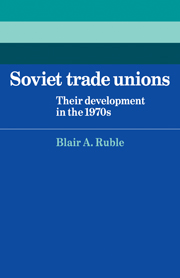Book contents
- Frontmatter
- Contents
- List of tables and figures
- Acknowledgments
- Abbreviations
- Introduction
- 1 Soviet trade union development: 1917–1956
- 2 Soviet trade union development: 1957–1980
- 3 Union–management–Party relations at the plant
- 4 The legal and social rights of Soviet workers
- 5 Do workers participate in Soviet management?
- 6 Patterns of union behavior
- 7 The international activities of Soviet trade unions
- Conclusion
- Notes
- Classified bibliography
- Index
3 - Union–management–Party relations at the plant
Published online by Cambridge University Press: 07 October 2011
- Frontmatter
- Contents
- List of tables and figures
- Acknowledgments
- Abbreviations
- Introduction
- 1 Soviet trade union development: 1917–1956
- 2 Soviet trade union development: 1957–1980
- 3 Union–management–Party relations at the plant
- 4 The legal and social rights of Soviet workers
- 5 Do workers participate in Soviet management?
- 6 Patterns of union behavior
- 7 The international activities of Soviet trade unions
- Conclusion
- Notes
- Classified bibliography
- Index
Summary
Few Soviet workers, let alone Western observers, are privy to the wheeling and dealing that takes place during closed meetings among factory managers, Party officials, and union chairmen. Nevertheless, the Western observer has an advantage that a Soviet worker does not: He can ask about such practices during an interview. Although responses to his queries may not be entirely candid, an anecdote told by a factory manager in conjunction with a tale told by a union official and a legal case summarized by a labor lawyer frequently create strong impressions as to what actually takes place behind closed office doors.
After several such interviews, it becomes possible to imagine a meeting among factory managers, union chairmen, and Party officials. Following the resignation of a trusted senior worker, for example, a union chairman might come to see a factory director and suggest that the plant must improve its recreation facilities if there is to be any hope of retaining its best workers. Such an event provides an opportunity for the union chairman to raise general issues concerning working and living conditions at the plant. In an effort to avoid further expenditures, the plant director might suggest that productivity is too low and that the factory cannot afford the costs of the necessary improvements, at which point the factory union chairman might link productivity to the overall work environment.
- Type
- Chapter
- Information
- Soviet Trade UnionsTheir Development in the 1970s, pp. 45 - 63Publisher: Cambridge University PressPrint publication year: 1981



